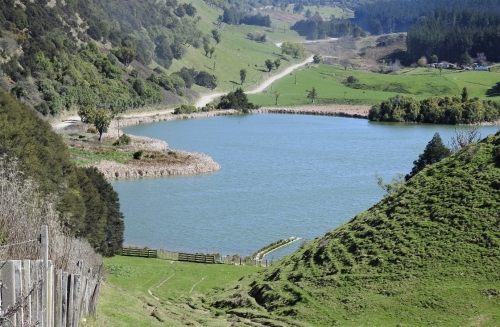
The beauty of Rotonuiaha is striking. Winding up the dirt road from Raupunga, foresty and farming dominate the landscape. As you come over the brow of a hill, the most beautiful lake is nestled below amongst Te Putere Marae and remnant native vegetation.
Rotonuiaha is the largest of the three Putere Lakes. The area holds deep spiritual links for the people who live there and many pa and urupā are signs of the Māori history and connectedness to the land and waters.
Ngāti Pāhauwera Development Trust (NPDT) environmental lead Bonny Hatami, Kaitiaki Kuki Green and locals Theresa Thornton and Walker Gilbert are working together to chip away at enhancing the mauri (lifeforce) of the lakes, as over the years the health of the waters have diminished. As local Kaumātua Gunner Gilbert says, the trouble started with the first top dressing planes in 1948.
Nutrient run off, invasive aquatic weeds and stock being in the waters have been the main problems. Monthly water testing, fencing stock out and planting the fringes of the lakes to prevent run off are among the first steps being taken.
Rotongaio, the smallest lake, has a fringe of raupō along the flattest side while steep farmland borders the rest. A cold wind whips across the lake, pushing up small waves onto the shore and chilling our faces as we climb down to take a look at the latest plantings and new fence.
There was plenty of support at a recent planting day with landowners and neighbours the Broad and Bennison whanau, Putere School, NPDT reserves team, Theresa and her nephew Deshay, Walker and EIT horticulture students all helping to plant 2700 native seedlings of manuka, kanuka, karamu and kahikatea on the steep slopes. This was achieved with funding from Biodiversity Hawke’s Bay Project Fund, Nga Whenua Rahui and Department of Conservation, while the fencing was done by NPDT through the DOC Community Fund.
One ancient matai tree remains standing watch over Rotongaio. A sign of what was before and the promise of what the future can bring.
30 September 2020
Disclaimers and Copyright
While every endeavour has been taken by the Hawke's Bay Regional Council to ensure that the information on this website is
accurate and up to date, Hawke's Bay Regional Council shall not be liable for any loss suffered through the use, directly or indirectly, of information on this website. Information contained has been assembled in good faith.
Some of the information available in this site is from the New Zealand Public domain and supplied by relevant
government agencies. Hawke's Bay Regional Council cannot accept any liability for its accuracy or content.
Portions of the information and material on this site, including data, pages, documents, online
graphics and images are protected by copyright, unless specifically notified to the contrary. Externally sourced
information or material is copyright to the respective provider.
© Hawke's Bay Regional Council - www.biodiversityhb.org / 027 231 9367 / info@biodiversityhb.nz